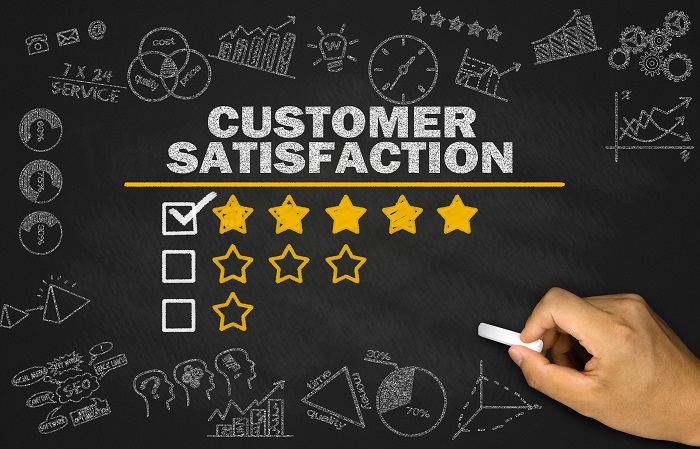
 Data Structure
Data Structure Networking
Networking RDBMS
RDBMS Operating System
Operating System Java
Java MS Excel
MS Excel iOS
iOS HTML
HTML CSS
CSS Android
Android Python
Python C Programming
C Programming C++
C++ C#
C# MongoDB
MongoDB MySQL
MySQL Javascript
Javascript PHP
PHP
- Selected Reading
- UPSC IAS Exams Notes
- Developer's Best Practices
- Questions and Answers
- Effective Resume Writing
- HR Interview Questions
- Computer Glossary
- Who is Who
How to Measure Customer Satisfaction?
Every day, unhappy customers cost firms millions of dollars. In fact, studies indicate that 80% of his clients are changing organizations as a result of subpar service. The very first step in dealing with this is admitting that more can be done. The next stage is to assess your performance by measuring client happiness. Customer satisfaction testing doesn't have to be difficult or expensive. In truth, integrating customer happiness measurement into your existing customer success plan is fairly simple.
Whatever method you choose, gathering client feedback via surveys and consumer data is the only surefire way to gauge satisfaction. Asking individuals about their experiences and comparing the results to quantitative reports are necessary for assessing customer sentiment accurately. A survey can be carried out in a variety of methods, depending on the survey's design, scheduling, sample size, and data analysis techniques. Whatever strategy you decide on, there are a few fundamental measures your company must follow to maximize its investment.
What Is Customer Satisfaction?
It may not seem like a concept that requires a specific explanation is customer satisfaction. The nuances, though, go beyond client happiness.
Customer happiness in business is much more than a sentiment. Customer satisfaction is a metric that expresses how happy customers are with a good or service. These metrics are the outcome of certain group brand interactions, which can be interpreted in several ways.
The 3 Cs of Customer Satisfaction
The three Cs of customer satisfaction underline the essential elements for maintaining a loyal consumer base. However, there is a catch ?

Consistency, consistency, and consistency are the three C's of customer happiness.
It's crucial to maintain service consistency if it's not already clear. But that does not imply that the company will continue to operate under the same product concept for the rest of the day.
Instead, there are three techniques to guarantee consistency in service delivery ?
Consistency in communication, emotion, and the customer journey. The main danger is that the customer's overall experience is uneven, even if these steps might seem apparent. These inconsistencies can compromise the customer's experience, whether it be because a blog article didn't live up to expectations or because a sales manager didn't give it his all during his follow-up calls.
What Are the Benefits of Monitoring Customer Satisfaction?
One important measure for SaaS organizations is customer retention. Building a current connection is far less expensive and time-consuming than acquiring new business. For long-lasting and profitable commercial relationships, customer loyalty is essential.
Customer happiness is a crucial component of customer retention. Disgruntled clients have no concerns about taking their company elsewhere after a terrible experience because they have so many options open to them. You must know how to assess customer happiness because it may be both a growth indicator and a cautionary metric against turnover.
How Customer Satisfaction is Measured?
Below are a few most used metrics when we come down to measuring customer satisfaction.
Customer Satisfaction Score
A tested statistic is the Customer Satisfaction Score (CSAT). Customers are addressed in this customer satisfaction survey using different iterations of a very simple query.
Please rate your experience working with our sales, customer service, and support teams. Typically, the scale falls into the following categories: Very Dissatisfied, Dissatisfied, Neutral, Satisfied, and Very Satisfied.
The higher the score, the more people react in the affirmative. CSAT is adaptable since it can be pertinent to how customers engage with your company. It's instantaneous and provides you with exact feedback regarding your unique experience. The best application of CSAT is to monitor quick shifts in a customer's consent both before and after adjustments or new activities. If your score drastically changes, you will know what worked and what didn't.
The customer's general perception of the business is not covered by this question, though. Similar to how marginally satisfied or disgruntled clients tend to completely dismiss questions, results are often biased. In the end, this does not anticipate consumer behavior and does not account for the possibility of corporate expansion. Although CSAT is a necessary metric, it will never be perfect.
Net Promoter Score
In order to solve the CSAT's lack of ability to predict customer loyalty, the Net Promoter Score was developed. The following describes the query?
How likely are you, on a scale of 1 to 10, to tell a friend about our product or service?
Three groups are thus formed from the respondents ?
Subtract the percentage of critics from the percentage of enthusiasts to arrive at NPS. Better results result with higher scores.

The questions are straightforward to understand and respond to. But dissatisfied consumers are more likely to reply than happy ones. While this could seem intimidating, it's actually a chance to concentrate on areas that want development and leave a lasting impact on unhappy customers.
NPS ratings, however, are essentially single-dimensional in a vacuum. In addition, without compensation, promoter responders won't genuinely make an effort to support your business.
Customer Effort Score
The Customer Effort Score approaches customer satisfaction measurement differently than the first two techniques. How much time, energy, or other resources were expended to address the issue, respond to the inquiry, or deliver the service?
Typically, the scale goes from 1 (my situation was very simple and easy to handle) to 5 (it was a huge headache). The better, the lower the score.
A now-famous article demonstrates that increasing devotion is not usually the result of over-satisfaction. The efforts expended on winning over the consumer eventually go towards keeping the customer out of problems. By saving clients time and effort, CES is a good indication of rising customer loyalty. You can also include an accessible answer box because the dial is locked, allowing your clients to exhale. A comment along the lines of "The customer service team was very helpful, however, if the FAQ was easy to explore, I wouldn't have phoned in the first place," for instance, is extremely beneficial. CES enables us to highlight areas of our service that require enhancement in order to better serve our clients.
Like any indicator, the utility of CES alone is constrained. Even while it considers the elements that are crucial for keeping clients, you still don't get the whole picture.
Taking Customer Satisfaction into Consideration
Your clients can purchase your goods and advise you on how to maintain them. It is crucial to understand whether measuring customer satisfaction aids a company in meeting consumer needs. With this guidance, we intend to make it easier for you to include more feedback from the client in your business plan.
Bain & Company, Inc., Fred Reichheld, and Satmetrix Systems, Inc. are registered trademark holders of the terms Net Promoter, Net Promoter System, Net Promoter Score, NPS, and NPS-related emoticons.
Conclusion
As we have established, gauging customer satisfaction requires factoring in a number of different things. To stay current, be discrete, and make sense of the vast amount of data you gather, you need to be creative. No metric is flawless on its own. The intersection of the data that has been gathered provides an accurate assessment of customer happiness.

